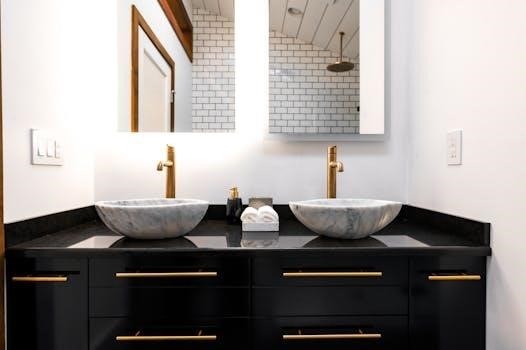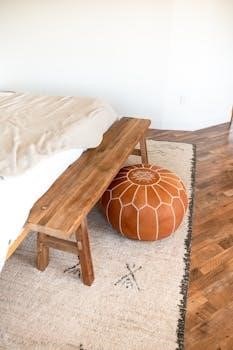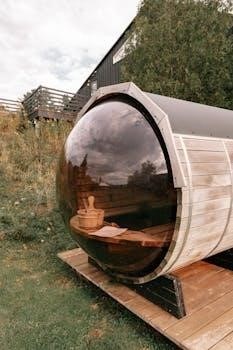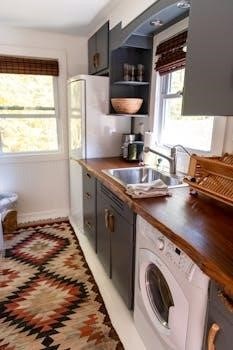metal loft bed with desk assembly instructions
Preparation Before Assembly
Before starting the assembly of your metal loft bed with desk, it’s crucial to verify that all components listed in the manual are present․ This includes checking for the frame pieces, desk parts, and all the necessary hardware like bolts and screws, ensuring no delays later on․

Checking All Parts Are Present
Prior to commencing the assembly of your new metal loft bed with desk, a meticulous check of all parts is absolutely essential․ This step helps to ensure a smooth and hassle-free construction process․ Begin by carefully unpacking all boxes and laying out the components on a clean, spacious surface․ Refer to the parts list provided in your assembly manual, and systematically compare each item you have with what’s listed․ Make sure you have all the frame components, including side rails, headboards, footboards, and support legs․ Verify the presence of all desk-related parts like the desktop panel, support structures, and any shelves․ It’s critical to also account for all hardware elements – bolts, screws, washers, nuts, and any specialized connectors․ If any part is missing or damaged, contact the manufacturer immediately to request replacements before you begin assembly․ This thorough initial check is pivotal for a successful assembly, saving you time and frustration․ Do not skip this important step․
Identifying All Hardware Components
Before you begin the physical assembly of your metal loft bed with desk, taking the time to accurately identify all hardware components is crucial․ This will streamline the construction process and prevent confusion later on․ Carefully separate and sort the various types of bolts, screws, washers, and nuts provided in the hardware package․ Use the assembly manual to cross-reference each component with its respective label or illustration․ You may find different sizes and types of bolts, such as those with Allen heads or standard Phillips heads; identify each type and place them in separate containers or trays․ Pay close attention to the washers, distinguishing between flat washers and lock washers, as their correct usage is essential for a secure assembly․ Also, locate any specialized connectors or joint pieces and familiarize yourself with their function․ Having all hardware components properly identified and organized will not only make the assembly process smoother but will also reduce the likelihood of using incorrect parts, which could compromise the integrity of the finished structure․ This step is key to a successful outcome․

Frame Assembly
Begin the frame assembly by connecting the main metal pieces to form the base structure, ensuring all joints are aligned correctly․ Refer to the manual for specific configurations, and use the correct bolts and screws to secure them․
Building the Base Frame
The initial step involves laying out all the metal frame components for the base on a clean, protected surface․ Carefully identify each piece using the assembly manual․ Begin by connecting the main side rails, usually the longest pieces, using the specified bolts and washers․ Ensure the bolts are hand-tightened initially to allow for adjustments later․ Next, attach the headboard and footboard sections to the side rails, paying close attention to the orientation․ Again, use the correct hardware and hand-tighten all connections․ Double-check that all parts are flush and that the base frame is square․ It’s crucial at this stage to have a stable foundation before proceeding․ Use a measuring tape to ensure the base frame matches the dimensions outlined in the instructions․ Finally, once you are satisfied with the alignment, fully tighten all bolts using the provided Allen key, but avoid over-tightening, as this can damage the frame or strip the screws․ This will create a solid base for the rest of the structure․
Attaching the Support Legs
With the base frame assembled, the next crucial step is attaching the support legs․ Begin by locating the designated leg pieces, ensuring they are oriented correctly as per the assembly manual․ Carefully align each leg with the corresponding corner of the base frame, paying close attention to any specific markings or pre-drilled holes․ Use the specified bolts, washers, and nuts to secure each leg firmly to the frame, starting by hand-tightening them․ It is essential to make sure the legs are attached evenly, ensuring that the bed will stand level; Double check the alignment before fully tightening all bolts․ Once the legs are secured, ensure they are plumb and that the frame stands level on all four corners․ Use a level to verify this, making adjustments if necessary․ After confirming the legs are stable and the frame is level, fully tighten all bolts using the Allen key․ Do not overtighten․ This stable leg support is vital for the overall structure and safety․
Installing the Ladder
The next step in the loft bed assembly is installing the ladder, which will provide access to the sleeping area․ First, identify the ladder components and the designated side of the bed frame for its attachment, which can often be specified in the manual․ Typically, the ladder hooks onto the side frame using provided brackets or screws․ Align the ladder’s mounting points with the corresponding points on the bed frame․ Attach the ladder securely using the appropriate hardware․ Begin by hand-tightening the screws or bolts․ Ensure the ladder is flush against the frame and securely attached to prevent any wobbling․ Double-check that the ladder is stable and can bear weight․ Once you are satisfied, fully tighten all the connections using the correct tools․ Verify that the ladder rungs are level and evenly spaced․ After installation, climb the ladder to double check for security and stability․ This ensures safe and easy access․

Desk Assembly
After the frame is assembled, it’s time to focus on the desk portion․ This involves attaching the desk panel and ensuring its support structure is secure, creating a functional workspace beneath the loft bed, which will ensure a sturdy desk․
Attaching the Desk Panel
To begin attaching the desk panel, carefully align it with the pre-drilled holes on the assembled frame․ The desk panel will typically be secured to the desktop front rail using joint connectors, as depicted in the assembly manual․ It’s crucial to ensure that the panel sits flush against the frame before proceeding․ Next, you’ll need to secure the desk panel to the support post and the desk back rail․ This is usually done using joint connectors that pass through metal plates․ These plates provide extra stability to the connection․ It’s important to tighten all joint connectors using the Allen key provided․ Remember not to overtighten as this could damage the parts․ Make sure that all connections are snug and that the desk panel is level․ If the desk is not level, it could impact the stability of the structure․ This step is critical for creating a secure and functional desk area under the loft bed․ This will help the user have a safe space while using the desk and ensure that it does not wobble or cause any accidents․
Securing the Desk Support Structure
Once the desk panel is attached, the next crucial step involves securing the desk support structure to the loft bed frame․ This generally involves connecting the support posts and any additional bracing elements that are part of the desk design․ Start by aligning the support posts with the designated locations on the bed frame․ Use bolts and washers to firmly attach the posts․ Make sure that all connections are aligned and flush before fully tightening them․ It’s essential to ensure that the support structure is properly aligned because any misalignment could compromise the desk’s stability․ Next, if there are any additional crossbars or support beams, connect them to the posts and the bed frame according to the manual․ These additional components add to the overall strength and stability of the desk․ Remember to use the appropriate hardware for each connection, and always tighten the bolts securely but not excessively․ A properly secured desk support structure is crucial for safe and functional use of the desk area of the loft bed, preventing any wobbling or instability․

Final Steps
With the main structure assembled, install the guardrails to ensure safety․ These are usually attached to the top of the bed frame using bolts․ Make sure they are securely fastened․ These provide a safe sleeping environment․
Installing the Guardrails
Once the main frame and desk components are securely assembled, the next crucial step involves installing the guardrails․ These safety features are essential, especially for loft beds, as they provide a barrier against accidental falls during sleep․ Begin by identifying the correct guardrail pieces, typically longer metal sections with pre-drilled holes․ Align these with the designated mounting points on the upper frame of the loft bed, often along the sides․ Use the appropriate bolts and washers, usually provided in the hardware pack, to attach the guardrails securely․ Ensure that the bolts are tightened evenly to prevent any wobbling or instability․ It is important to recheck all the bolts of the guardrails to make sure that they are securely fastened for maximum safety․ A well-installed guardrail provides a safe sleeping environment, giving parents and users peace of mind․ The guardrails should fit snugly, without gaps, to prevent any potential hazards․ Remember to consult your specific assembly manual for any variations in guardrail design and installation steps․ Proper installation of guardrails is not just a step in assembly but a critical safety measure․
Adding the Mattress Slats
After the guardrails are securely in place, it’s time to add the mattress slats․ These slats are crucial for providing a stable and supportive base for your mattress, eliminating the need for a box spring․ Begin by identifying the slat pieces; they might be metal or wooden, depending on your bed’s design․ These should be evenly spaced across the bed frame, according to the instructions in your manual․ Some loft beds use a slot structure, which fixes the slats firmly, preventing noise and movement․ Others may require screws or fasteners to secure the slats to the frame․ Ensure that each slat is properly aligned and securely attached․ This is important to guarantee proper weight distribution and to prevent the mattress from sagging or shifting․ A correctly installed slat system will not only support the mattress but also enhance its breathability, keeping it fresher for longer․ Double check your work to make sure each slat is tightly attached to the frame․ The stability of the bed and comfort of the user depends on the correct installation of the slats;
Final Check and Tightening
With the mattress slats in place, the final step is a comprehensive check and tightening process․ This is a critical stage to ensure the overall safety and stability of your metal loft bed with desk․ Begin by systematically inspecting every bolt, screw, and joint connector․ Make sure each one is properly tightened․ Use the Allen key provided in the assembly kit to make final adjustments․ Do not use power tools for tightening; they may cause damage or strip the screws․ Be sure to check all connections including the joints of the frame, support legs, ladder, guardrails, desk panel, and desk support structure․ Ensure that no parts are loose or wobbly․ Pay special attention to the joints that connect the frame to support legs and the points where the ladder is attached to the frame․ A thorough review will prevent future issues of instability or unsafe conditions․ Once you have checked all parts, give one final tightening to be sure․ This step guarantees the bed will be sturdy and ready for use․
